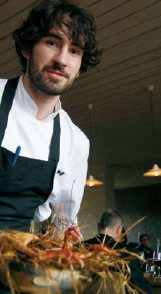Eric Robertson’s karnemelk stampers
Almost a week before the 2014 edition of Gent-Wevelgem, Eric Robertson and his girlfriend were looking for wild garlic along a path in Belgium. He was confident he’d find some. The weather had been warm and the edible wilds had been growing. Robertson, a Brantford, Ont., native who is the head chef at De Vitrine in Gent, planned to used the wild garlic in dishes at his restaurant that week.


Almost a week before the 2014 edition of Gent-Wevelgem, Eric Robertson and his girlfriend were looking for wild garlic along a path in Belgium. He was confident he’d find some. The weather had been warm and the edible wilds had been growing. Robertson, a Brantford, Ont., native who is the head chef at De Vitrine in Gent, planned to used the wild garlic in dishes at his restaurant that week.

While Robertson’s restaurant is in a town known to cycling fans, Omloop Het Nieuwsblad starts blocks from his apartment and he once lived at the foot of the Kemmelburg, his connection to cycling goes deeper than location. In 2008, he rode with Team R.A.C.E. Pro, the Steve Bauer outfit that would become SpiderTech. He started racing on a mountain bike, but switched to road his second year as a junior. Track followed too. Some of his highlights include the one-day race in Philadelphia where he faced some ProTour teams, racing in France and Spain with the national under-23 team and one second-place and two third-place finishes in the madison event at track nationals. Eventually, it became time to hang up his bike.
“I always wanted to be a chef,” Robertson said. “I gave cycling a couple ofyears with my eggs all in that basket. I had a couple of good opportunities with Steve, which prolonged it. But, once I reached under-23, I had a decision to make.” Robertson went to culinary school in Stratford, Ont. From there, he worked in Toronto, then Belgium, travelled and recently came back to Belgium.
The wild garlic Robertson picked isn’t the only local ingredient used at De Vitrine. The restaurant uses food sourced locally from farmers in Flanders.Most nights, the restaurant is full with about 35 diners who get a set menu with eight courses. Robertson’s recipe for Canadian Cycling isn’t on the menu at De Vitrine, but it’s classic Belgian fare. “Karnemelk stampers are a time honoured Flemish fisherman’s dish that is usually served with shrimp, lobster or fresh fish,” Robertson said. “The name and ingredients vary between regions throughout Belgium. Karnemelk stampers is its West Flanders name,which translates to ‘buttermilk mash.’”
Karnemelk Stampers
Ingredients
3 lb. Yukon gold potatoes, peeled and chopped into equal-size pieces
2 l buttermilk
200 g soft cow’s milk cheese, such as brie or camembert
100 g butter
salt
Directions
- In a pot, cover the potatoes with buttermilk. Bring the buttermilk and potatoes to a light simmer.
- Cut the cheese and butter into smaller pieces and keep out at room temperature to ensure they melt into the potatoes well.
- Once the potatoes are cooked, after roughly 20 minutes, strain and reserve the remaining buttermilk.
- Mash the potatoes through a food mill or using a masher while mixing the cheese and butter.
- Add the warm buttermilk a little at a time back into the mixture until the mash is the desired consistency: smooth and not very thick and clumpy. Season to taste with salt and serve with fish.
Serves 6
Nutritional Information
For one serving:
Calories 979
Carbs 106 g
Saturated Fat 29 g
Protein 14 g
Fibre 12 g
